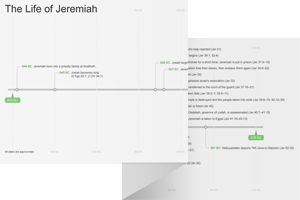29:1–32 Jeremiah’s conflict with false prophets extended even to the exilic community in Babylon. This passage records the contents of a letter Jeremiah sent to the exiles encouraging them to settle in for the long haul and ignore their prophets, who preached a short exile and an imminent return home. Jeremiah tells the exiles to build houses, plant crops, carry on with their lives, and even pray for the peace and prosperity of the foreign cities where they live. This advice elicits a strong reaction from another prophet in exile named Shemaiah; his letter to the priest Zephaniah, demanding Jeremiah’s punishment, also is recorded here. Jeremiah’s response to Shemaiah is the same as his response to Hananiah (Jer 28:15–16): Jeremiah accuses him of rebelling against Yahweh and making the people of Judah trust in a lie. |
29:1 the words of the letter Jeremiah’s letter—probably a papyrus scroll—is delivered by envoys dispatched to Babylon by King Zedekiah. It is addressed to the entire community that was taken into exile in 597 bc.
the exiles See note on 26:17. Refers to the civil leaders of the community in exile (see Ezek 8:1 and note; Ezek 14:1 and note).
29:2 Jeconiah The Hebrew here is yekhonyah (often translated as Jeconiah), which is another name for Jehoiachin. See note on Jer 22:24.
the queen mother Jehoiachin’s mother was named Nehushta (see 2 Kgs 24:8).
the court officials The Hebrew text refers here to castrated men, who often served as government officials in the ancient Near East. See note on Neh 1:11; and note on Esth 1:10.
29:3 Elasah This individual is mentioned only here. He is likely another son of Josiah’s scribe (see note on Jer 26:24).
Gemariah Possibly the son of Josiah’s high priest (2 Kgs 22:4), but both Gemariah and Hilkiah were common names during this period. Another Gemariah is mentioned in Jer 36:10–12.
Nebuchadnezzar See note on 21:2.
29:5 Build houses The exiles should treat their situation as a permanent move.
29:7 seek the prosperity of the city The Hebrew term used here, shalom, conveys all aspects of peace, safety, security, welfare, and prosperity. Jeremiah’s advice to seek the well-being of their enemy’s homeland would have been surprising and offensive, but the success and prosperity of the exiles depended on the peace and stability of their new home.
29:8 your prophets who are in your midst, and your diviners There were prophets in exile, but Yahweh insists that He did not speak through them to promise peace and restoration (v. 9).
dreams The prophets were falsely claiming to receive divine revelation in dreams. See note on 23:32.
29:9 they are prophesying falsely to you Compare 23:25–26.
29:10 seventy years A period of time symbolic of a human lifespan (see note on 25:11).
bring you back to this place Restoration will come, but not until after a lengthy period of exile resulting in genuine repentance (see v. 14).
29:11 the plans Yahweh assures the exiles that His long-term plan is good and that He has not abandoned them. Their national calamity would have precipitated feelings of hopelessness and abandonment.
29:14 I will restore A promise of salvation based on Deut 30:3 and a common image in the prophetic books (Jer 30:3; 33:7; Isa 1:26; Ezek 16:53; 39:25).
29:15 has raised up prophets for us in Babylon See Jer 29:8 and note. Their statement indicates doubt about which prophets to believe. Jeremiah gives the exiles the same message he proclaimed in Jerusalem: the city will be destroyed, not spared (vv. 16–19). There will soon be no homeland for them to return to. His message paraphrases and borrows imagery from the vision of the figs in 24:1–10.
29:16 who sits on the throne of David Zedekiah. See note on 21:1.
29:17 sword, the famine, and the plague A standard declaration of divine judgment (compare 24:10). See 14:12 and note.
rotten figs Alludes to Jeremiah’s vision in 24:1–10 (see note on 24:1).
29:18 a horror, and an object of hissing, and a disgrace Compare 24:9.
29:21 Ahab, the son of Kolaiah, and concerning Zedekiah Jeremiah calls out two of the prophets in exile mentioned in v. 15. Neither man is mentioned elsewhere in the Bible. See vv. 8–9.
he will strike them before your eyes If Ahab and Zedekiah were preaching that Babylon would be overthrown soon, enabling the Jews to go home, their messages would have been viewed as politically subversive.
29:23 they have committed adultery with the wives of their neighbors Likely a metaphor for idolatry (see 23:13–15).
29:24 Shemaiah Jeremiah’s correspondence includes a reply to Shemaiah, who is otherwise unmentioned in the Bible. The location of Nehelam is unknown.
29:25 Zephaniah The letter is addressed primarily to the priest in charge of the temple courts. The sender inquires why Jeremiah has not been arrested for his insurrection (see note on 21:1).
29:26 into the stocks and into the neck iron This verse probably reflects duties of the temple’s chief officer. See 20:1 and note; 20:2 and note.

|
About Faithlife Study BibleFaithlife Study Bible (FSB) is your guide to the ancient world of the Old and New Testaments, with study notes and articles that draw from a wide range of academic research. FSB helps you learn how to think about interpretation methods and issues so that you can gain a deeper understanding of the text. |
| Copyright |
Copyright 2012 Logos Bible Software. |
| Support Info | fsb |
 Loading…
Loading…

